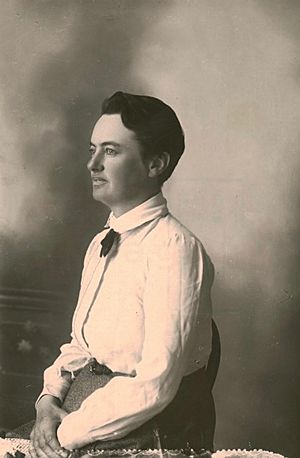Edith Durham facts for kids
Quick facts for kids
Edith Durham
|
|
|---|---|
 |
|
| Born |
Mary Edith Durham
8 December 1863 |
| Died | 15 November 1944 (aged 80) |
| Academic work | |
| Main interests | Albanian history, Culture |
| Notable works | High Albania |
| Influenced | Robert Elsie |
Mary Edith Durham, FRAI (8 December 1863 – 15 November 1944) was a British artist, anthropologist, noted Albanophile and writer who became famous for her anthropological accounts of life in Albania in the early 20th century.
Contents
Early life
Durham was the eldest of nine children. Her father, Arthur Edward Durham, was a distinguished London surgeon. She attended Bedford College (1878–1882), followed by the Royal Academy of Arts, to train as an artist. She exhibited widely and contributed a number of detailed drawings to the amphibia and reptiles volume of the Cambridge Natural History (published 1899).
Balkan expeditions
After the death of her father, Durham took on the responsibilities of caring for her sick mother for several years. It proved an exhausting experience. When she was 37, her doctor recommended that she should undertake a foreign vacation to recuperate. She took a trip by sea down the coast of Dalmatia, travelling from Trieste to Kotor and then overland to Cetinje, the capital of Montenegro. It gave her a taste for southern Balkan life, which retained for the rest of her life.
Durham travelled extensively in the Balkans over the next twenty years and focused particularly on Albania, which then was one of the most isolated and undeveloped areas of Europe. She worked in a variety of relief organisations, painted and wrote, and she also collected folklore and folk art.
She contributed frequently to the journal Man and became a Fellow of the Royal Anthropological Institute. Her writings, however, were to earn her particular fame. She wrote seven books on Balkan affairs. High Albania (1909) is the best known and is still regarded as the pre-eminent guide to the customs and the society of northern Albania's highlands.
Collections
Much of Durham's work was donated to academic collections following her death. Her papers are held by the Royal Anthropological Institute, London, her diaries are in the Bankfield Museum, Halifax along with her collections of Balkan costume and jewellery given in 1935. Further gifts of mostly Balkan artefacts were given to the British Museum in 1914 and to the Pitt Rivers Museum, Oxford and the Horniman Museum, London. Some items from her textile collection were displayed in a 2020 exhibition.
See also
 In Spanish: Edith Durham para niños
In Spanish: Edith Durham para niños


